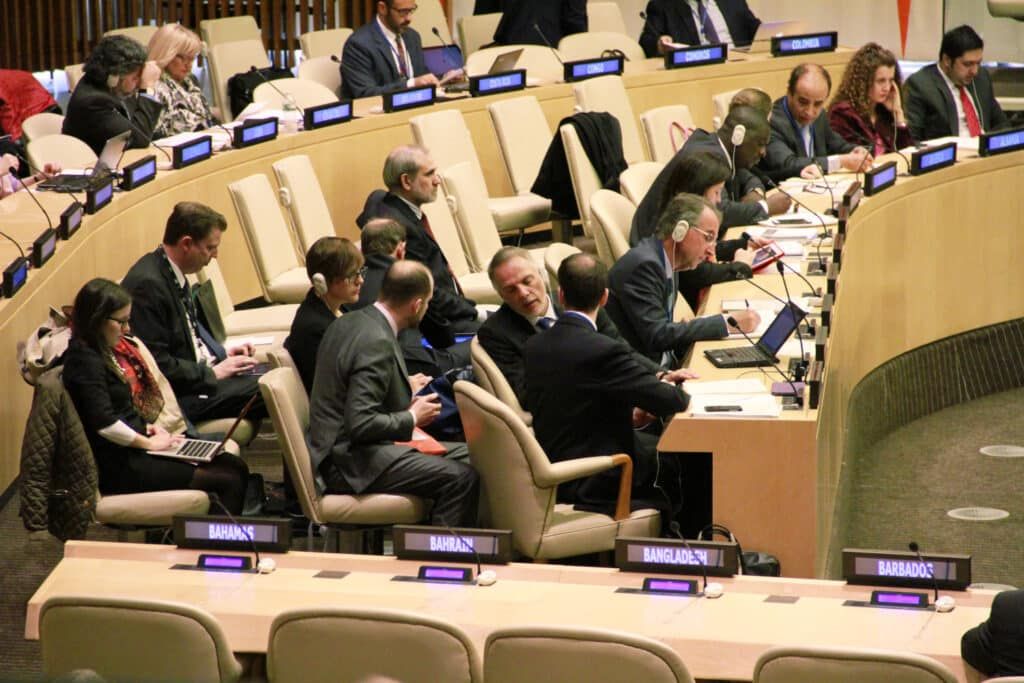How the ban treaty addresses the inherent injustices of nuclear weapons
By Alexander Kmentt | February 2, 2023
 Alexander Kmentt of Austria (center) talks with fellow delegates at the NPT review conference on May 1, 2015. (Credit: International Campaign to Abolish Nuclear Weapons / ICAN)
Alexander Kmentt of Austria (center) talks with fellow delegates at the NPT review conference on May 1, 2015. (Credit: International Campaign to Abolish Nuclear Weapons / ICAN)
Editor’s note: This commentary is part of a roundtable on nuclear injustice.
In their recent essay in the Bulletin, Frankiska Stärk and Ulrich Kühn are right to highlight the injustice of the so-called “global nuclear order” as endemic to all three policy domains of nuclear deterrence, nonproliferation, and disarmament. They are also right in saying that the justice-injustice dualism should be given more research focus.
The Treaty on the Prohibition of Nuclear Weapons (TPNW), also known as the ban treaty and which entered into legal force in early 2021, specifically addresses this issue. As the authors correctly point out, the ban treaty focuses on the legacy of nuclear weapons use and testing campaigns by highlighting their impact on affected communities. The humanitarian impact of nuclear weapons has been severe and devastating, and it spans several generations as highlighted by the many powerful testimonies from hibakushas—the Japanese term for atomic bomb survivors—and victims of nuclear testing in Kazakhstan and the Pacific, among other places. The treaty’s positive obligations on victim assistance and environmental remediation are the first provisions in an international treaty that recognizes and seeks to remedy this injustice.
But the ban treaty is also a relevant prism to look more broadly at the injustice of the nuclear status quo. It is a contribution to the “democratization” of the nuclear debate. It has given voice to the majority of countries disenfranchised in this debate by the nuclear weapon states, which traditionally exert strong substantive and procedural control.
The ban treaty came about through a UN General Assembly-mandated process and was adopted by a vote of the clear majority of UN member countries. The UN’s most democratic body allows for voting for example on resolutions, which is in clear contrast to other multilateral fora, where nuclear weapons are dealt with and where decisions can only be taken by consensus. Because of the abuse of the consensus rule, the Conference on Disarmament has been blocked since 1997 and several review conferences of the Nuclear Non-Proliferation Treaty (NPT) have failed to agree on concrete steps for the implementation of the NPT disarmament obligations and commitments.
The ban treaty also follows an unequivocal and nondiscriminatory approach to nuclear weapons. It is based not on the rationale of who “should” and “should not” have such weapons but, instead, it posits that the humanitarian consequences and risks of these weapons are so grave that no responsible country should possess them. The fact that the treaty was achieved against the fierce opposition of the nuclear-armed states underscores both the frustration and sense of injustice about the nuclear status quo felt by the majority of countries in the world.
The ban treaty’s underlying rationale rests on the breadth and scale of humanitarian consequences in case nuclear weapons are used. New research suggests that even a “limited” nuclear conflict could result in a global famine. These findings raise profound issues about the legal, ethical, and justice aspects of the nuclear status quo. In short, the ban treaty highlights that nuclear deterrence, as practiced by a limited number of nuclear weapons-possessing countries, comes at the expense of the security of all other countries, whose populations could end up as collateral damage in much more severe ways than previously understood.
The legitimacy deficit of the current deterrence is obvious. Ultimately, nuclear deterrence doctrines are based on the readiness to use these weapons, with potentially global catastrophic consequences and the gravest violations of international humanitarian law.
But it’s not even only an injustice across countries. If anything was ever to go wrong with nuclear deterrence, injustice would span across generations.
State parties to the ban treaty have expressed this perspective unequivocally in the declaration adopted at their first meeting in June 2022: “Far from preserving peace and security, nuclear weapons are used as instruments of policy, linked to coercion, intimidation and heightening of tensions. This highlights now more than ever the fallacy of nuclear deterrence doctrines, which are based and rely on the threat of the actual use of nuclear weapons and, hence, the risks of the destruction of countless lives, of societies, of nations, and of inflicting global catastrophic consequences.”
Understanding the various endemic injustices of the global nuclear order is both timely and important. To that aim, the origins of the ban treaty, the history of its negotiations, and its underlying rationale can serve as a useful prism for research priority in nuclear policy analysis.
Editor’s note: The views expressed in this commentary are the author’s and do not necessarily represent the positions of the Austrian Foreign Ministry.
Together, we make the world safer.
The Bulletin elevates expert voices above the noise. But as an independent nonprofit organization, our operations depend on the support of readers like you. Help us continue to deliver quality journalism that holds leaders accountable. Your support of our work at any level is important. In return, we promise our coverage will be understandable, influential, vigilant, solution-oriented, and fair-minded. Together we can make a difference.















